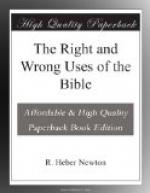The primitive Church was, as we well know, agitated by contending factions. Two leading parties dominated all minor schools of thought; the Jewish Christians, who naturally wanted to keep within the old religion, and who would have made a reformed Judaism, and the Gentile Christians who as naturally objected to being herded within Judaism, and who wanted to make a new and universal society. The first party rallied under the name of Peter, and the second used the name of Paul. There was imminent danger that the new society would break apart, with fatal consequences to posterity. Real and deep as were the differences between Peter and Paul, they did not, in all probability, sunder these great natures as widely as their followers imagined. There must have been meeting points between such souls, in love with the one Master. To find these convergences and construct out of them a peace-platform on which both wings of the new society might stand, was the aim of The Acts. It embodied genuine journals of a traveling companion of St. Paul, notes of his addresses in various cities, traditions lost to us outside of this book, of Peter’s conciliatory attitude and utterances; and groups these historic fragments into a sketch, in which the two apostles are shown as dividing equally the labors of founding the Christian Church, as preaching the same views, and acting in cordial harmony. This book is a sign of the disposition to draw together which was gaining ground among the primitive churches, a disposition fostered largely by this writing; out of which process of comprehension and conciliation arose the Catholic Church, naming its great cathedrals after St. Peter and St. Paul.
IV.
The books which are of a composite character should be read in their several parts, and traced to their proper places in history.
Thus, for example, in reading Isaiah uncritically we pass from the fragment of history that forms our thirty-ninth chapter, to the magnificent strain of impassioned imagination which opens with the fortieth chapter, as though there were no hiatus; and we proceed straight through this latter section of the book, taking it all as written in the reign of Hezekiah, that is, in the latter part of the eighth century before Christ. We thus view this second section of Isaiah from a wrong standpoint. The panorama of its visions becomes blurred. We cannot focus the glass upon the objects in its field. The real significance and beauty of this noblest reach of prophetic imagination evanishes from our vision.




